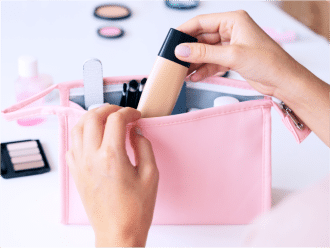The cosmetics industry is one of the largest industries in the world. With a projected 2028 value of over 400 billion US dollars[1], it’s no surprise that new products are constantly launched into the market, bringing with them a host of new ingredients. Now more than ever, manufacturers need to ensure that chemicals in cosmetics are safe and correctly labeled so consumers know exactly what they are getting. However, many cosmetics companies still struggle with labeling their products in a compliant and easy-to-understand way, hindering their success as they try to expand in the EU.
Enter CosIng, a database of over 15,000 common ingredients created by the European Commission (EC) in 2008 to help manufacturers address the challenge.
We look at the CosIng database to see how it can help regulatory affairs professionals achieve the product compliance they need.
- What is CosIng?
- Why was CosIng created?
- Who uses CosIng, and how does it impact the industry?
- Cosmetics ingredients databases in other countries
- How to ensure compliance with cosmetics ingredients and labeling regulations
What is CosIng?
CosIng is the official online database for cosmetics ingredients in the EU. It is a glossary of 15,000 common cosmetic ingredient names compiled and updated by the European Commission. It was created in 2008, and since 2009, all nomenclature on cosmetics labeling must be drawn from this list (Article 19(1)(g) of Regulation (EC) No 1223/2009[2]).
This regulation was designed to ensure that all cosmetics on the market are suitable for human use and are environmentally sound. It also gives consumers more information about the potential risks of using certain ingredients, allowing them to make informed choices about the products they use.
However, it is important to note that the CosIng database holds no legal value – just because an ingredient is listed does not mean it is safe. Cosmetics manufacturers must still conduct a product safety assessment to ensure any cosmetic products brought to market are safe for both human health and the environment.
The database can be searched using CAS, ELINCS or EINECS numbers, and includes regulated and banned cosmetics substances as noted in[3]:
- Cosmetics Regulation (EC) No 1223/2009 of the European Parliament and of the Council[4]
- Cosmetics Directive 76/768/EEC (cosmetics directive), as amended[5]
- Glossary of common ingredient names[6] for the purpose of labeling cosmetic products placed on the market (as established by Decision (EU) 2019/701 of 5 April 2019[7])
- Opinions on cosmetic ingredients of the Scientific Committee for Consumer Safety (list of SCCS opinions[8])
Why was CosIng created?
The beauty industry was notoriously opaque. It is difficult to find out what is allowed and what isn’t, and it’s even harder to get a list of ingredients that are banned. The European Commission launched CosIng as a way for companies and authorities to check common ingredient names and the potential risks they pose, and ensure cosmetic products are correctly labeled. It includes all data since the adoption of the Cosmetics Directive in 1976, and new entries are added each year.
Who uses CosIng, and how does it impact the industry?
The CosIng database is used by many different groups of cosmetics professionals: Regulatory authorities, regulatory affairs teams working in cosmetics companies, beauty professionals, and even consumers who want to check the ingredients in a particular product. It is an additional but crucial step for consumer safety, and any cosmetics company looking to sell its products in Europe must adapt its strategy accordingly.
Regulatory affairs professionals
CosIng helps companies comply with legislation and avoid product recalls. By providing information about ingredients, it allows regulatory affairs professionals to make informed decisions on what they can and cannot use in their cosmetics products, and how they should be labeled on the packaging. For instance, in Europe, over 1600 chemicals or substances including chlorine, cadmium chloride, lead and mercury, are banned from use in cosmetics.

Beauty professionals
Beauty professionals can double-check product labels and ingredients for allergens in makeup, lotions, and other skin-care products before use to ensure they don’t cause an allergic reaction.
Consumers
The database also benefits consumers, allowing them to make educated decisions about beauty brands and the products they use on their skin or in their hair.
To sum up, CosIng:
- Saves time on research by providing all the required information in one place
- Helps users make informed decisions
- Promotes transparency in the industry and boosts consumer confidence
Cosmetics ingredients databases in other countries
United States
The U.S. FDA website includes information on requirements for ingredient nomenclature and labeling cosmetic products for the international market[9]. When it comes to cosmetic ingredient safety, the FDA recommends that manufacturers use safety data that’s already available on individual ingredients and on products with similar formulations, such as the safety data published in PubMed[10], TOXNET[11], and the Cosmetic Ingredient Review (CIR) website[12].
Japan
The Japan Cosmetic Industry Association (JCIA) has a public database of cosmetic ingredients names listed in Japanese. The Japanese Pharmaceutical and Medical Devices Law (PMDL) requires a complete list of ingredients in Japanese on all cosmetics product packaging. Companies can use the JCIA database to ensure compliance.
Australia
In Australia, cosmetics ingredients are searchable in the Australian Inventory of Industrial Chemicals[13]. There is no single list of banned or restricted chemicals for viewing or downloading. Bans and restrictions on chemicals and cosmetics ingredients are regulated by each state and territory[14]. Cosmetic products that make therapeutic claims (therapeutic goods) have separate standards and regulatory controls for safety, quality, efficacy, labeling and claims, which can be found on the Therapeutic Goods Administration website[15].
Need regulatory support on cosmetics ingredients? Get in touch with RegASK expertsHow to ensure compliance with cosmetics ingredients and labeling regulations
Selling your cosmetic products in foreign markets can be a great way to grow your business. However, you must ensure that you comply with local laws and regulations, research compliance requirements for each country before you start selling. Regulators require a safety evaluation and clear labeling of all ingredients used in your cosmetic products, so it is crucial to research which ingredients are restricted or prohibited.
Researching ingredient regulations and keeping track of regulatory changes is time-consuming and labor-intensive, but RegASK can help.
RegASK is a RegTech leader with rich experience in the areas of cosmetics ingredients and labeling compliance. Using our AI-powered regulatory intelligence platform and global network of local regulatory experts, we track domestic cosmetic regulations for you and ensure your product ingredients and labels stay compliant. From regulatory monitoring, product development and regulatory submissions to go-to-market plans, we map out every step for you.
Why risk rejection from authorities or consumer mistrust? Connect with our experts today for everything you need to know about cosmetics ingredients and product compliance.
References:
[1] Fortune Business Insights – The global cosmetics market is projected to grow from $287.94 billion in 2021 to $415.29 billion in 2028 at a CAGR of 5.0% in forecast period, 2021-2028
[2] European Commission – CosIng – Glossary of ingredients
[3] European Commission – Cosmetic ingredient database
[4] European Union – Regulation (EC) No 1223/2009 of the European Parliament and of the Council of 30 November 2009 on cosmetic products (recast)
[5] Council Directive 76/768/EEC of 27 July 1976 on the approximation of the laws of the Member States relating to cosmetic products
[6] European Commission – 96/335/EC: Commission Decision of 8 May 1996 establishing an inventory and a common nomenclature of ingredients employed in cosmetic products
[7] Official Journal of the European Union – COMMISSION DECISION (EU) 2019/701 of 5 April 2019 establishing a glossary of common ingredient names for use in the labelling of cosmetic products
[8] European Commission – Public Health – Preliminary Opinions open for comments
[9] U.S. FDA – Cosmetic Ingredient Names
[10] U.S. Government – National Library of Medicine
[11] U.S. Government – How to access TOXNET information
[12] Cosmetic Ingredient Review – Find Ingredient Reviews and Documents
[13] Australian Government Department of Health – The Australian Inventory of Industrial Chemicals (Inventory)
[14] Australian Government – Banned or restricted chemicals
[15] Australian Government – Advertising: when cosmetics are regulated as therapeutic goods

